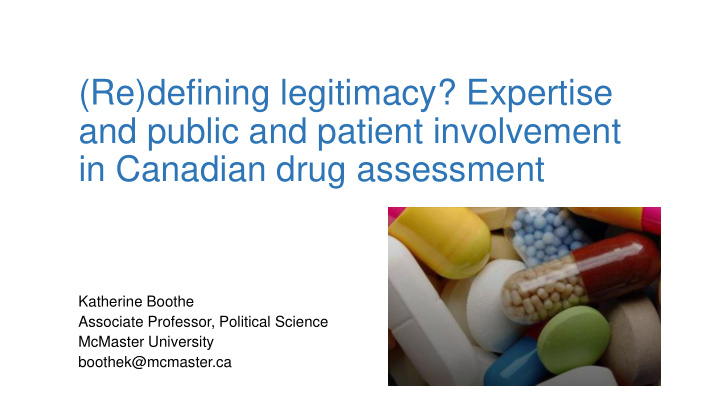



(Re)defining legitimacy? Expertise and public and patient involvement in Canadian drug assessment Katherine Boothe Associate Professor, Political Science McMaster University boothek@mcmaster.ca
Disclosure I have no actual or potential conflict of interest in relation to this topic or presentation. This research is funded by an Insight Development Grant from the Social Sciences and Humanities Research Council of Canada and approved by the McMaster Research Ethics Board.
Context • 2006: add public or patient members to drug advisory committees • 2010: accept submissions from patient advocacy groups • Driven by patient demands and need to increase public legitimacy • Experts see the process as already rigorous and effective
Have technical members’ ideas about legitimacy changed Research question since public and patient involvement was introduced?
Data • Consultancy reports and parliamentary hearings • 2005: Ekos Research Associates, Common Drug Review • 2007: Standing Committee on Health, hearings and report • 2011/2012: SECOR, CADTH Evaluation phases I and II • 2012: SECOR, CADTH Patient Input Evaluation • 12 interviews with current or former technical members of CDEC, pERC, Ontario CED drug advisory committees (2014-2018)
Theoretical framework • Describe two broad conceptions of legitimacy • Scientific: “good” (efficient, equitable, rigorous) decisions • Democratic: “fair” (inclusive, accountable, transparent) process
Describing ideational stability and change Room for Scientific democratic legitimacy is legitimacy? paramount Before/during adoption of After experience with public public and patient and patient involvement, involvement, early 2000s 2014-present
Findings: role of lay members • Perception: having public and patient members on the committee enhances accountability and transparency “If you don’t have a [lay] member… there could always be a critic that says: how do I really know you’re emphasizing “I think that the presence of patient values, there’s no patient on your [lay] members is essential to committee, there’s no public member. really make sure that when we And so I agree with that criticism, and I go out with a recommendation, think that having someone there, from an it is clear to the public why that optics point of view, makes a lot of recommendation was made” – sense.” – Tech member 2016 Tech member 2018
Findings: role of patient submissions • Consistent emphasis on standards of scientific evidence and concerns about bias • Consensus that patient input could improve drug listing decisions “For many conditions, the patient ultimately needs to be the person to advise: what are the outcomes that are important to them?” – Tech member 2016
Findings: role of patient submissions • Challenge: should patient input be more like scientific evidence? “I certainly don't think there's any theory behind how that information [patient input] is presented, whereas there's a lot of theory behind how the clinical evidence and the economic evaluation stuff is presented.” – Tech member 2018 “I would like the patient groups to be a bit more critical of the evidence, if they can be.” – Tech member 2016
Contributions • Plausibility of concepts of scientific and democratic legitimacy as a way to understand participant views • Most acceptance of democratic versions of legitimacy re: role of lay members • Acceptability of patient submissions more likely to be framed in terms of approaching/contributing to scientific legitimacy
Questions and comments? boothek@mcmaster.ca
Recommend
More recommend